Japan
Wood Products Prices
Dollar Exchange Rates of 25th
Oct
2021
Japan Yen 114.16
Reports From Japan
No change as election result
declared
The ruling coalition retained a comfortable majority in the
House of Representatives following the General Election
on 31 October. The Liberal Democratic Party (LDP) has
been in power for over 60 years. In welcomed the victory
of Prime Minister Fumio Kishida Japan's business leaders
called for strong leadership to revive the economy.
State of emergency lifted acros the country
With more than 70% of the population fully
vaccinated against COVID-19 the rate of the roll-out is
expected to slow down and the country could just make
the target 80% by the end of November. Despite an
initially slow rollout, Japan is now ranked No. 3 for its
vaccination rate among the Group of Seven industrialised
countries.
Tokyo and Osaka have now lifted all coronavirus
restrictions on restaurants and bars, meaning the entire
country is now free from covid restrictions. However,
infections are still being reported but a very low level and
there are concerms that the country will experience an
additional wave of infections.
Economic Security Minister appointed
Just before announcing the General Election the ruling
party prepared a report on economic security which,
analysts say, focuses on the economic and trade ties with
China and the associated risks. The report notes Japan¡¯s
heavy reliance on trade with China and how this was
seriously disrupted due to the coronavirus outbreak.
In a mid-year White Paper the government said several
nations, including Japan, had been spurred to strengthen
economic security after the pandemic exposed supply
chain risks.
Japan appointed an economic security minister whose role
will be to ¡°develop strategies and a legal framework to
enable Japan to boost economic security encompassing
supply chains, resources, innovative technologies and
relevant infrastructure.¡±
See:
https://www.japantimes.co.jp/news/2021/10/25/business/economy-business/china-japan-economic-security/
Growth forecast lowered
The Bank of Japan (BoJ) has lowered its growth and
inflation forecasts for this fiscal year and will maintain its
current loose monetary policy in an attempt to support the
fragile economic recovery.
The BoJ Governor warned that the disruptions of supply
chains will last for some time heightening risks for the
economy as costs will rise for companies and households.
The BoJ now forecast a 3.4% growth down from the
previous 3.8% projection.
See:
https://mainichi.jp/english/articles/20211028/p2g/00m/0bu/031000c
Cost push inflation ¨C no sustainable price growth
Consumer prices rose in September for the first time since
the early stages of the corona pandemic in March 2020.
Given rising energy prices inflation is set to rise in coming
months but analysts say the rise will be modest compared
with other advanced economies as low wage growth
dampens consumption. As it is a cost push rather than
demand pulled inflation it is unlikely that there will be a
sustainable price growth.
According to the latest data from Japan¡¯s Cabinet Office
consumer confidence rose in October to its highest level in
30 months buoyed by the decline in covid infections and
the lifting of the state of emergency. For the first time in
four months the Cabinet Office raised assessment of
consumer sentiment saying it ¡°continues to pick up.¡±
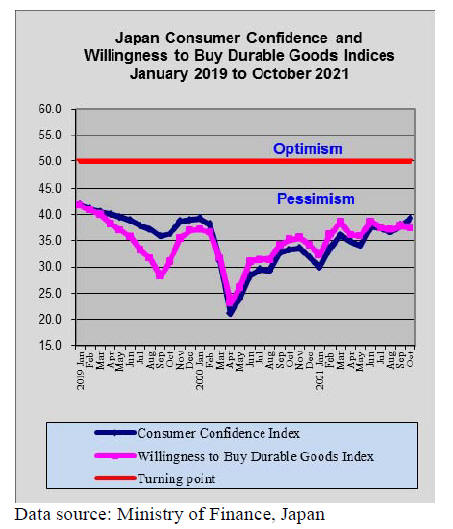
Housing ¨C starts still not at 2019 levels
September housing starts were up 4% year on year but had
not recovered to 2019 levels agaist which they were down
6%. September marked the second straight monthly
decline in starts although the drop in September was only
slight.

First three quarter housing starts
Housing starts in the first three quarters of 2021 were up
slightly on the same period in 2020 but still around 9%
below pre-pandemic 2019 levels.
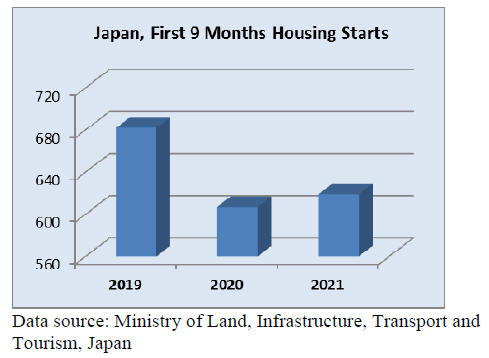
BoJ Governor - weak Yen does more good than
harm
The Yen dipped to a new low against the US dollar
recently. A weak Yen typically drives exports higher but
when, as now, it is combined with surging prices for
imports the economic recovery from the pandemic will be
disrupted.
Wholesale prices have also been rising to such an extent
that soon Japanese companies that currently absorb the
higher costs may have to start passing them on to
consumers. The yen's recent slide has raised concern that
this could hurt business and consumer sentiment by
making things more expensive but the BoJ Governor said
a weak yen does more good than harm.
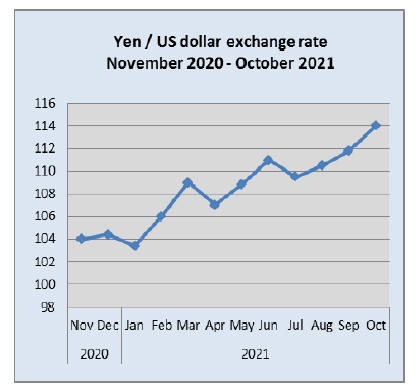
Import update
Furniture imports
Household spending fell in August as state of emergency
restrictions weighed on sentiment. Private consumption
has been a weak spot the Japanese economy since the
surge in Delta variant infections. Furniture and homeware
retailers in Japan have opened new stores to cater for
people working from home.
The impact of the pandemic on furniture imports in Japan
has varied. Looking at imports for the first eight months of
2019, 2020 and 2021 imports of office furniture in 2020
held up well against the value of 2019 and the value of
imports in the period Jan-Aug 2021 rose significantly.
There was a decline in the value of wooden kitchen
furniture in 2020 compared to 2019 but the rebound in
2021 was not enough to lift the value of imports up to
2019 levels. In contrast to imports of wooden office and
kitchen furniture, imports of wooden bebroom furniture
have steadily increased from 2019.
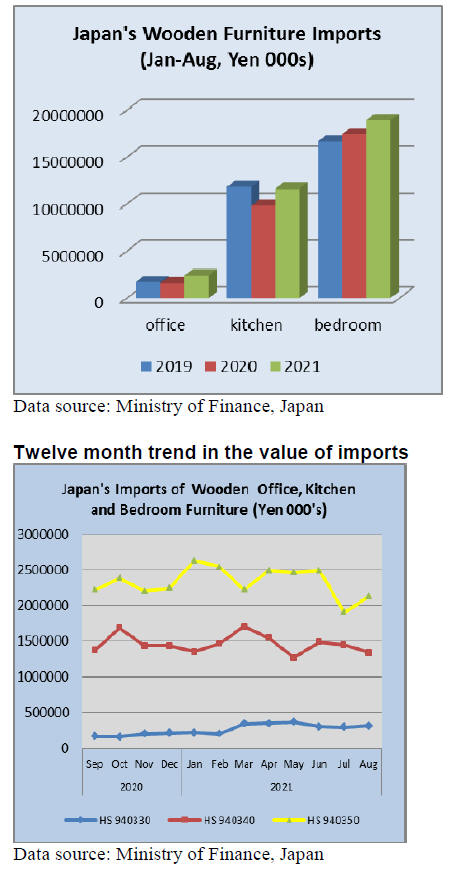
Office furniture imports (HS 940330)
Year on year, the value of imports of wooden office
furniture (HS940330) rose over 43% in August and
compared to August 2019 there was an almost doubling of
the value of imports.
The top shipper of wooden office furniture in August this
year was China whose share of imports was 78%. The
other two significant shippers in Auguest were the UK, a
new comer to this segment of the Japanese market and
Poland, a regular shipper to Japan. Shippers in ASEAN
countries made up most of the balance.

Kitchen furniture imports (HS 940340)
There was a further drop (7%) in the value of Japan¡¯s
imports of wooden kitchen furniture in August. As could
be anticipated there was a rise in imports compare to 2020
but the level of August 2021 imports still has not matched
that of 2019.
In August 2021 wooden kitchen furniture shipments from
manufacturers in the Philippines and Vietnam dominated
imports (47% and 31% respectively). If shipments from
China are added to those from the two top shippers then
90% of shipments are accounted for. the other shippers in
August were Thailand, Indonesia and Germany.
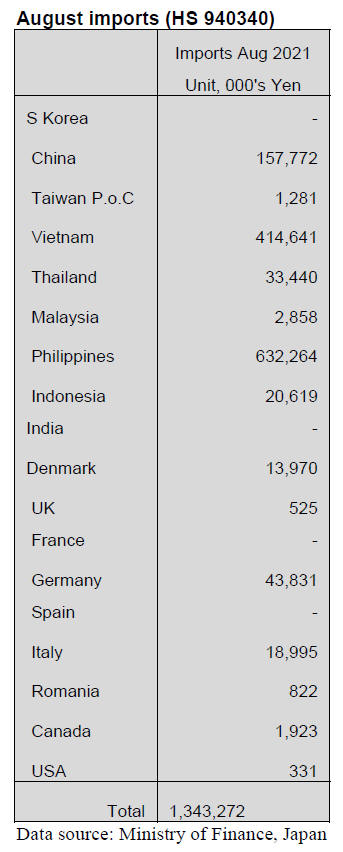
Bedroom furniture imports (HS 940350)
Month on month, August arrivals of wooden bedroom
furniture were up 12% reversing the steep drop in the
value of July imports. However, compared to August 2020
there was a decline in the value of imports of 9% but there
was a rise over the same month in 2019.
The main suppliers in August were, as in previous months,
manufacturers in China, Vietnam and Thailand. The value
of imports from Chian and Vietnam were higher than in
July but of the other three main suppliers, Thailand
Malaysia and Indonesia it was only Malaysia that saw it
month on month shipments rise in August.

Trade news from the Japan Lumber Reports (JLR)
The Japan Lumber Reports (JLR), a subscription trade
journal published every two weeks in English, is
generously allowing the ITTO Tropical Timber Market
Report to reproduce news on the Japanese market
precisely as it appears in the JLR.
For the JLR report please see:
https://jfpj.jp/japan_lumber_reports/
Total wood demand and supply in 2020
The Forestry Agency disclosed total wood demand by use
in 2020. Total wood demand in 2020 is 74,439,000 cbms,
9.1% less than 2019.
Decrease of industrial wood demand (lumber, plywood,
pulp and wood chip) of 61,392,000 cbms, 13.9% less is
the main reason of decline.
Wood demand for fuel is 12,805,000 cbms, 23.3% more,
seven straight years¡¯ increase. These are the largest after
59 years since 1961. Self-sufficiency rate and use are
different from 1960s but scale of demand and balance of
two is back to beginning of high economic growth days.
In industrial wood, import wood decreased by 17% while
domestic is 7.7% less so degree of self-sufficiency
improved to 35.8%, 2.4 points up. Degree of selfsufficiency
including fuel and others is 41.8%, 4 points up
and this is the first time of over 40% in 48 years since
1972.
For the supply, domestic is 31,149,000 cbms, 0.5% more
and the imports are 43,290,000 cbms, 15% less. Increase
of domestic is mainly fuel wood of 1,995,000 cbms, which
filled decrease of industrial wood. Demand of logs for
lumber and plywood manufacturing in 2020 declined
while surplus logs are used for fuel. Also domestic log
export increased.
In total industrial wood demand, it is first time in eleven
years since 2009 when new housing starts were down to
780,000 units that log demand for lumber is less than
25,000,000 cbms and for plywood is less than 9,000,000
cbms. Drop this time is the same reason with decline of
housing starts.
Housing starts in 2020 are 815,000 units, 9.9% less than
2019 because of COVID 19. In particular, wood-based
units are 469,000 units, 10.3% less, which caused decrease
of log demand for lumber by 10.9% and for plywood by
14.8%. Decrease of demand for pulp and wood chip is
17.5% because demand for paper shrunk by COVID 19.
It is the first time in 48 years since 1972 that the demand
for pulp and wood chip dropped down to 26,000,000
cbms. Shrinking trend continues and 2021 will have less
than 2020 as Nippon Paper closed paper manufacturing at
Kushiro pant. Wood demand for fuel continues increasing
with increased supply of imports.
Plywood mills in the North East
Plywood mills in the North East are facing high prices of
logs by short supply. 4 meter larch logs for plywood is
about 20,000 yen per cbm delivered and 4 meter cedar
logs for plywood is about 13,000 yen per cbm delivered.
They are 2,000-3,000 yen higher than before last summer.
Plywood mills continue buying logs even with high prices
since precutting plants and dealers complain shortage of
plywood.
Log supply in the North East had been smooth until last
spring as log production recovered by front loading
harvest of the National Forest timber then in summer, log
production dropped as log suppliers concentrate on
replantation, which is usual move in summer months and
housing starts are increasing in the region.
Supply of imported wood products stayed low particularly
from Europe so the demand of domestic wood like lumber
and laminated lumber sharply increased after middle of
August. Now lumber mills, laminated lumber mills and
plywood mills fight to get logs with each other.
Log prices for lumber mills started climbing up since
middle of August and 4 meter larch log prices are 19,000
yen per cbm FOB deck and 3.65 meter cedar log prices in
Akita are 17,000 yen. Plywood mills made agreement with
local forest unions and log suppliers so log supply is rather
stable but there are no extra logs to buy in open market.
Seasonally log supply in the North East should be easing
by increase of clear cutting of private forests but busy
demand for lumber and plywood would last through next
year so log price are likely to stay high for some time in
the region.
South Sea (tropical) logs and lumber
Both logs and lumber of South Sea hardwood continue
stagnant. Rainy season started in September in Sarawak,
which is about a month earlier than normal years then
labor shortage is critical at logging camps so log
production will remain low until next spring.
In Japan, log inventories for South Sea hardwood lumber
are getting low but the demand is limited. Movement of
Chinese made laminated free board has been steady as
domestic dealers have ample inventory and are cautious of
procuring high priced items since future demand is
uncertain.
The suppliers are in no hurry to sell at low prices because
cost of raw materials and transportation has been climbing.
Supply of South Sea hardwood lumber is tight due to
delayed arrivals by production delay and shortage of
containers but the demand is also low.
Plan to build super high wood hybrid building
Tokio Marine Holdings, Inc (Tokyo) and Tokio Marine-
Nichido Co., Ltd. (Tokyo) decided to rebuild Tokio
Marine-Nichido building in Marunouchi, Tokyo. It will
be three under-ground floors and 19 floors high. Total
height would be about 100 meters. It aims to build the
highest and largest wood hybrid high tower building with
maximum use of domestic wood. Volume of wood used
would be about 10,000 cubic meters.
Basic idea is sustainability concept Tokio Marine group
made up, which pursue the highest environmental
performance with active use of domestic wood. It would
have the maximum measures to deal with natural disasters
so it will have anti-earthquake structure, measures for
flood, emergency power generators and will have wide
space for people who have difficulty returning home.
Regarding use of domestic wood, not only structural
members like post but other use will be the highest level
unprecedented in any other cases.
By using matured domestic timber, cycle of plantation,
harvest, utilization and replantation is supported as user.
Also it contributes conservation of timberland, protection
of water resources and revitalization of local economy.
Roof greening would ease heat island phenomenon.
Utilization of rain water and recycle system of water
should conserve water resources.
It aims to obtain premium, which is the highest level of
award by LEED, which is international certification
program of green building.
Kyushu¡¯s three way fight to get logs
Wood biomass power generation plants struggle to have
enough logs to run the plants. After imported wood
products supply got tight, demand for domestic logs
sharply climbed. Competing export log prices shot up to
10,000-12,000 yen per cbm delivered loading ports while
log prices for power generation plants are 6,500-7,000 yen
per cbm delivered wood chip plants.
Log production increased after the demand increased
because log suppliers do not have to make sorting at
landing so it¡¯s easier for log suppliers to ship out camp-run
logs. At log auctions, biomass power generation plants
cannot compete with sawmills and log exporters so
securing logs is becoming very hard now.
In 2020, log prices stayed low so that power generation
plants had plenty of logs and some had to stop accepting
logs but log supply for power plants in Kagoshima in June
and July this year decreased. Power plants in Northern
Kyushu suffered low log supply of 20-30% down
compared to 2020 but now it is improving and the worst
season seems over.
There are three way fights among sawmills, log exporters
and power generation plants and there are some comments
that log export should have some limit to protect domestic
industry.
|